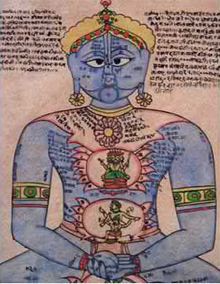
The Puranas as text of India
Most major religious traditions around the world have a text or group of texts that function as sacred literature for the tradition. Whether the Qur’an in Islam or the Hebrew Bible in Judaism, these texts are intended to provide answers to the ”big” life questions like ”why are we here?” and ”how did we get here?” They are oriented towards the ”sacred” or ”other,” basically something, whether a deity or concept, greater than everyday life and oneself.
The Puranas, literally ”ancient” writings, function as one part of scripture for the Hindu tradition. These texts were written over a long period of time from about the fourth century BCE to the eleventh century and were ascribed to Vyasa, the Hindu sage who is also credited with writing the famous epic Mahabharata. The Puranas offer answers to the big life questions by detailing how the world was created and who created it. There are two major components to this. First are myths, which are traditional stories about past events, usually involving gods and goddesses. The second component, which goes hand in hand with myths, are genealogies, or lists of ancestors and descendants.
The ”Five Signs” of the Puranas
The Puranas contain myths and genealogies, written in a flowing form like an epic poem, to explain the history and importance of religious rituals, duties, and developments. There are ”five signs” or marks in the Puranas that are standards for all the major Puranas to meet. First, there is a depiction of the creation of the universe. These are your traditional stories of how the world was created, who created it, and why it was created. In the Hindu tradition, forces of evil often caused chaos and destruction, so the second sign is the repeated creation of the universe after it has been disrupted.
The third sign is, perhaps, the most well-known: it is the tales of the gods and goddess and their genealogies, like who their parents and children are. The fourth sign deals with the first humans and their earthly reigns. The fifth and final sign of the Puranas is the solar and lunar dynasties. Essentially, two beings claimed one was descended from the sun and one from the moon, and this sign tells of those dynasties. Now that we have an idea of what the Puranas are, let’s look at a few examples.
Mahapuranas
There are a few major groupings of the Puranas. The first and most important of these is the Mahapuranas, or the ”greater” Puranas. These are called the ”greater” Puranas not because they are better than the others, but because most Hindus accept them as sacred literature. If you are familiar with the Star Wars movies, you probably know some people do not consider Episodes One, Two, and Three a real part of the Star Wars canon, while others do; but most everyone agrees Episodes Four, Five, and Six are the true Star Wars at its core. The Puranas are like this: the Mahapuranas are the Episodes Four, Five, and Six that most people accept as canon.
Bhagavata Purana
There are 18 different Mahapuranas dedicated to different gods and one of the most popular Mahapuranas is the Bhagavata Purana. This Purana is concerned with depicting bhakti, or devotion. In this case, the bhakti is directed towards Vishnu, the preserver god. The Bhagavata Purana tells the story of Krishna, the youthful incarnation of Vishnu, as a child. This is probably the first time the popular childhood stores of Krishna were written in the Hindu language of Sanskrit. The author of the Purana reflects on its importance and the role of Vishnu/Krishna in it, writing, ”’The Lord Vishnu dwells in this arcane Purana, he speaks through it.”’
Leave A Comment